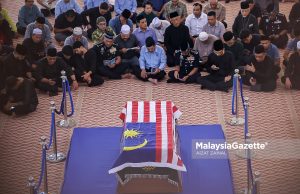It is really tragic that after waiting for more than two years, the families of the 15 crew and 283 passengers of MH 17 are still in the dark as who really shot down that plane?
On 19 July 2014, Ukrainian president said the Malaysian Airlines crash in his country was a “terrorist attack”. Meanwhile, warring parties in Ukraine’s troubled eastern region blamed each other for shooting down the Malaysia passenger jet.
There was one theory that the plane was shot down by Ukraine forces as a false flag attack. There was another theory that the plane was targeted and destroyed in order to kill the 100 AIDS researchers on board (who were headed to an AIDS conference).
There was also allegedly a news report that Igor Girkin, leader of the separatists, had taken the credit for shooting down the plane. He said that his troops had shot down a Ukranian military transport. Upon discovering later that it was a civilian airliner which was shot down, he denied any involvement, saying that his forces had no weapons capable of shooting down an aircraft flying at 33,000ft, where MH17 was when it was shot down.
In the days and weeks that followed, intelligence reports indicated that the missile that brought down MH17 was a Russian Buk M1 self-propelled air defence system, known also by its NATO reporting name of SA-11 “Gadfly”. Introduced in 1979, its latest updated version is known as the SA-17 “Grizzly”. Both weapons are commonly used by Russia and other nations to whom Russia exported them.
These Russian-built missiles have a range of 42km (26 miles), capable of a speed of 850 metres/sec (1,900mph) and an operational ceiling of 25km (82,000ft). They can be launched in just 11.5 seconds.
Four days after the crash, two Russian generals accused the Ukrainian government of deliberately pushing MH17 off its flight path into the war zone. They highlighted a momentary blip on Russian radar, arguing that this showed a Ukrainian Su-25 fighter jet, armed with missiles guaranteed to hit targets within a range of three miles.
Western defence analysts, however, rejected the Russian defence ministry’s claim that a Ukrainian Su-25 shot down MH17. Nick de Larrinaga, European editor of IHS Jane’s Defence Weekly, said the idea is “absolute nonsense”.
On 13 October 2015, the Dutch Safety Board concluded that Malaysian Airlines Flight MH17 crashed as a result of a Russian-made Buk missile. The weapon used to hit the plane was a 9N314M-model warhead carried on the 9M38M1 missile, as installed on the Buk surface-to-air missile system.
The missile had struck the front left of the plane causing other parts to break off, killing all 298 people on board. The report did not say who fired the missile, but said that airspace over eastern Ukraine should have been closed.
Board president Djibbe Joustra said the impact pattern could not have been caused by an air-to-air missile or an internal explosion. Instead, a warhead carried by a surface-to-air missile had detonated above the left-hand side of the cockpit, causing structural damage. He added that paint had been found on metal fragments within the plane that matched with missile fragments on the ground. There were sufficient reasons to close off its airspace but Ukraine did not do that – and on the day of the crash, 160 flights flew over the area in question.
The Dutch Safety Board found that around 800 pieces of shrapnel had ripped through MH17 – clear evidence of the deadly power only a ground-to-air missile could deliver. The Buk missile has a 70kg (154lb) warhead, which is far more powerful than the warheads on the air-to-air missiles fired from fighter jet.
Unfortunately the Board does not have the authority to apportion blame under the rules governing international crash investigations. Joustra however told reporters that pro-Russian rebels were in charge of the area from where the missile that hit MH17 had been fired.
Rejecting the report, Russia’s aviation agency said that some of “the key conclusions of the Dutch Safety Board’s final report on the Malaysia Airlines flight MH17 crash were unsubstantiated and inaccurate.” Oleg Storchevoy, deputy head of the agency, said that the final report did not reflect many important facts mentioned by the Russian side. He added that “ Even assuming the aircraft was brought down by a Buk surface-to-air missile, the description of fragments provided in the report does not match the strike elements used in the 9N314M warhead.”.
In May 2016, in his meeting with Russian president Vladimir Putin, Malaysian Prime Minister Datuk Seri Najib Tun Razak had said that Malaysia wants the perpetrators of the shooting down of MH 17 to be brought to justice.
On 27 September 2016, the Prime Minister told the media that he will wait for the final report on the tragedy, which was due to be tabled on the following day by the Dutch-led Joint Investigation Team. Thereafter the countries affected will discuss the next course of action. “We remain committed to bringing the culprits to justice,” he said at a joint press conference with Germany’s Chancellor, Angela Merkel.
The Prime Minister said he will call for a meeting with the other countries which had lost their citizens in the tragedy. “Together we will decide the next course of action. We must see to it that those responsible are punished,” he said. “We owe it to the families. The families want justice. So we will pursue this,” he added.
Earlier on, there was a proposal to establish a special tribunal for MH 17. However, in July 2015, Russia had vetoed the draft resolution (tabled at the UN Security Council) to set up an international tribunal into the MH17 air disaster. In view of that veto, the likelihood of a special tribunal like ICTY (International Criminal Tribunal for Yugoslavia) is zero.
Since the Dutch report had not identified any specific person or groups of persons responsible for shooting down MH 17 (a sad limitation under the rules governing the investigation) we are still left wondering who actually fired the Buk missile, if indeed it was the missile that brought down Malaysian plane? — MalaysiaGazette

















